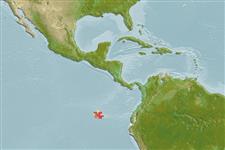Environment: milieu / climate zone / depth range / distribution range
Ecologie
marien demersaal; diepte 2 - 9 m (Ref. 28023). Tropical
Southeast Pacific: Endemic to the Galapagos Islands.
Lengte bij maturiteit / Grootte / Gewicht / Leeftijd
Maturity: Lm 3.3, range 3 - 3.6 cm
Max length : 5.0 cm SL mannelijk / geslacht onbekend; (Ref. 28023)
Known from tide pools and shallow coastal regions. Inhabits black volcanic sand and coarse, white coral sand, where it often occurs together with (Ref. 28023). Platygillellus rubellulus (Ref. 28023).
Levenscyclus en paargedrag
Maturiteit | Voortplanting | Paaien | Eieren | Fecunditeit | Larven
Grove, J.S. and R.J. Lavenberg, 1997. The fishes of the Galápagos Islands. Stanford University Press, Stanford, 863 p. (Ref. 28023)
Status op de Rode Lijst van het IUCN (Ref. 130435: Version 2024-1)
Gevaar voor de mens
Harmless
Gebruik door de mens
Tools
Speciale rapporten
Download XML
Internetbronnen
Estimates based on models
Preferred temperature (Ref.
123201): 23.5 - 24.6, mean 23.8 °C (based on 14 cells).
Fylogenetische diversiteitsindex (Ref.
82804): PD
50 = 0.5000 [Uniqueness, from 0.5 = low to 2.0 = high].
Bayesian length-weight: a=0.00389 (0.00180 - 0.00842), b=3.12 (2.94 - 3.30), in cm total length, based on all LWR estimates for this body shape (Ref.
93245).
Trofisch niveau (Ref.
69278): 4.0 ±0.6 se; based on size and trophs of closest relatives
Fishing Vulnerability (Ref.
59153): Low vulnerability (10 of 100).
